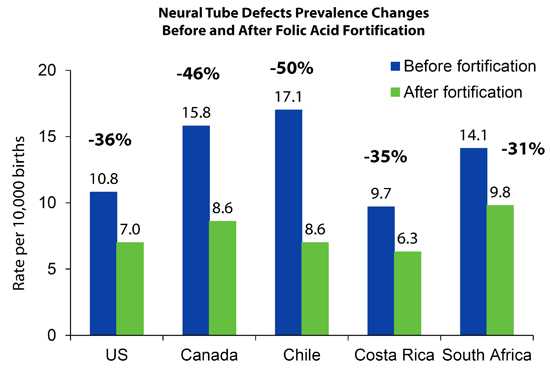Data & Statistics
- In the United States, 3,000 pregnancies are affected by neural tube defects every year (1).
- Hispanic women have higher rates of neural tube defects than non-Hispanic women in the United States (2).
- Worldwide, there are more than 300,000 babies born with neural tube defects each year (3).
- The total lifetime direct cost of care for a child born with spina bifida in the United States is estimated to be $791,900 (4).
- Increasing folic acid intake among women of childbearing age can help prevent 150,000-210,000 of the more than 300,000 neural tube defects that occur each year in low- and middle-resource countries (5).

Key Findings
Key Findings: Global Burden of Neural Tube Defects
The journal, PLOS ONE, has published a study describing the burden of neural tube defects in many countries and gaps in available data on neural tube defects worldwide.
(Published June 17, 2016)
Key Findings: Assessing the Association between Natural Food Folate Intake and Blood Folate Concentrations
The journal Nutrients has published a new study that assessed the relationship between the amount of natural food folate consumed by women and their blood folate concentrations.
(Published April, 2015)
Key Findings: Blood Folate Concentrations and Risk of Neural Tube Defect-Affected Pregnancies: Where Does the United States Stand?
Birth Defects Research Part A has published a new study that looked at the amount of folate in the blood (“blood folate concentrations”) among women in the United States in relation to their risk of having a baby affected by a neural tube defect.
(Published April, 2015)
Key Findings: Population Red Blood Cell Folate Concentrations for the Prevention of Neural Tube Defects
This study describes the relationship between women’s blood folate concentrations and the risk of having a baby affected by a neural tube defect.
(Published July, 2014)
Key Findings: Fortification of Corn Masa Flour With Folic Acid in the United States
Article about the fortification of corn masa flour with folic acid in the United States and how it can improve health outcomes for Hispanics.
(Published May, 2014)
References
- CDC. Spina Bifida and Anencephaly Before and After Folic Acid Mandate — United States, 1995–1996 and 1999—2000. MMWR 2004; 53(17): 362-5.
- Williams LJ, Rasmussen SA, Flores A, Kirby ES, Edmonds LD. Decline in the prevalence of spina bifida and anencephaly by race/ethnicity: 1995-2002. Pediatrics. 2005 Sep:116(3):580-6.
- Shibuya K, Murray CJ. Congenital anomalies. In: Health dimensions of sex and reproduction: the global burden of sexually transmitted diseases, HIV, maternal conditions, perinatal disorders, and congenital anomalies. Murray CJ, Lopez AD, eds. Boston, Massachusetts: the Harvard School of Public Health on behalf of the World Health Organization and the World Bank; 1998:455-512.
- Grosse SD, Berry RJ, Tilford JM, Kucik JE, Waitzman NJ. Retrospective assessment of cost savings from prevention: Folic acid fortification and spina bifida in the U.S. American Journal of Preventive Medicine. January 2016 [epub ahead of print].
- CDC. CDC Grand Rounds: Additional Opportunities to Prevent Neural Tube Defects with Folic Acid Fortification. MMWR 2010; 59(31);980-4.
- Page last reviewed: April 26, 2017
- Page last updated: March 31, 2016
- Content source:


 ShareCompartir
ShareCompartir